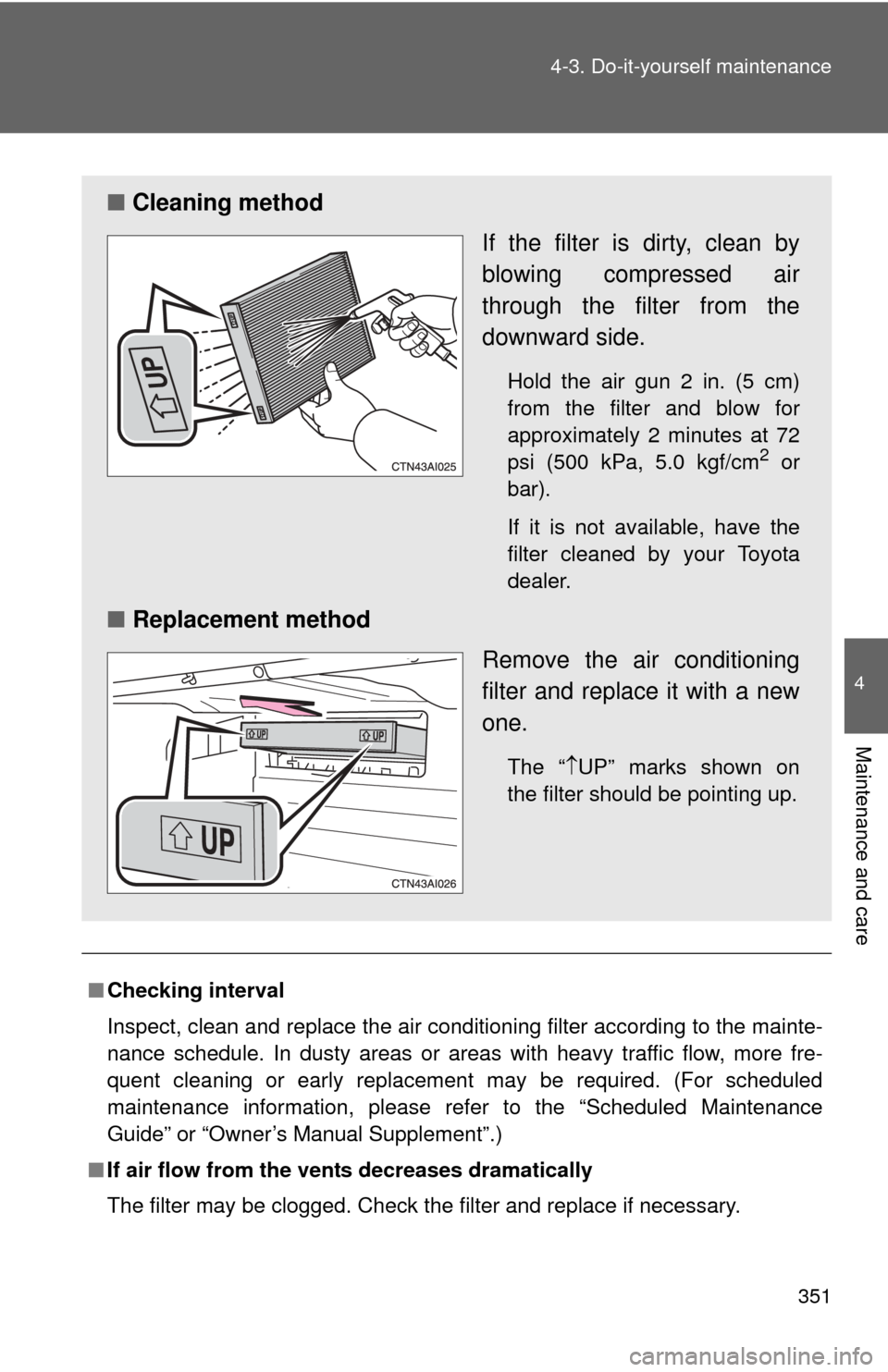Page 343 of 476
343
4-3. Do-it-yourself maintenance
4
Maintenance and care
NOTICE
■Repairing or replacing tires, wheels and tire pressure warning
valves and transmitters
When removing or fitting the wheels, tires or the tire pressure warning
valves and transmitters, contact your
Toyota dealer as the tire pressure
warning valves and transmitters may be damaged if not handled cor-
rectly.
■To avoid damaging the tire pressure warning valves and transmit-
ters
Do not use liquid sealants on flat tires.
■Driving on rough roads
Take particular care when driving on roads with loose surfaces or pot-
holes.
These conditions may cause losses in tire air pressure, reducing the
cushioning ability of the tires. In addition driving on rough roads may
cause damage to the tires themselves, as well as the vehicle’s wheels
and body.
■If tire inflation pressures become low while driving
Do not continue driving, or your tires and/or wheels may be ruined.
Page 347 of 476
347
4-3. Do-it-yourself maintenance
4
Maintenance and care
CAUTION
■Proper inflation is critical
to save tire performance
Keep your tires properly inflated. Otherwise, the following conditions
may occur and result in an accident causing death or serious injury.
●Excessive wear
●Uneven wear
●Poor handling
●Possibility of blowouts resu lting from overheated tires
●Poor sealing of the tire bead
●Wheel deformation and/or tire separation
●A greater possibility of tire damage from road hazards
NOTICE
■When inspecting and adjusting tire inflation pressure
Be sure to reinstall the tire valve caps.
Without the valve caps, dirt or mo isture could get into the valve and
cause air leakage, which could result in an accident. If the caps have
been lost, replace them as soon as possible.
Page 350 of 476
350
4-3. Do-it-yourself maintenance
Air conditioning filter
The air conditioning filter must be cleaned or changed regularly to
maintain air conditioning efficiency.
■ Removal method
Vehicles with smart key system: Turn the “ENGINE START
STOP” switch OFF.
Vehicles without smart key system: Turn the engine switch
OFF.
Open the glove box. Slide off
the damper.
Apply pressure to the glove
box as shown to disconnect
the claws.
Remove the filter cover.
STEP1
STEP2
STEP3
STEP4
Page 351 of 476

351
4-3. Do-it-yourself maintenance
4
Maintenance and care
■
Checking interval
Inspect, clean and replace the air conditioning filter according to the mainte-
nance schedule. In dusty areas or areas with heavy traffic flow, more fre-
quent cleaning or early replacement may be required. (For scheduled
maintenance information, please refer to the “Scheduled Maintenance
Guide” or “Owner’s Manual Supplement”.)
■ If air flow from the vents decreases dramatically
The filter may be clogged. Check the filter and replace if necessary.
■ Cleaning method
If the filter is dirty, clean by
blowing compressed air
through the filter from the
downward side.
Hold the air gun 2 in. (5 cm)
from the filter and blow for
approximately 2 minutes at 72
psi (500 kPa, 5.0 kgf/cm
2 or
bar).
If it is not available, have the
filter cleaned by your Toyota
dealer.
■ Replacement method
Remove the air conditioning
filter and replace it with a new
one.
The “UP” marks shown on
the filter should be pointing up.
Page 352 of 476
352 4-3. Do-it-yourself maintenance
NOTICE
■To prevent damage to the system
●When using the air conditioning system, make sure that a filter is always
installed.
● When cleaning the filter, do not clean the filter with water.
Page 362 of 476

362 4-3. Do-it-yourself maintenance
20 EFI NO.310 AMultiport fuel injection system/
sequential multiport fuel injection
system
21 EFI NO.2 15 AMultiport fuel injection system/
sequential multiport fuel injection
system
22 S-HORN 7.5 A Horn
23 A/F 20 AMultiport fuel injection system/
sequential multiport fuel injection
system
24 MPX-B 10 A Gauges and meters
25 EFI NO.1 10 ATheft deterrent system, smart key
system, multiport fuel injection sys-
tem/sequential multiport fuel injec-
tion system, electronic throttle
control system
26 HORN 10 A Horns
27 H-LP(RL) 15 A Right-hand headlight (low beam)
28 H-LP(LL) 15 A Left-hand headlight (low beam)
29 H-LP(RH) 15 A Right-hand headlight (high beam)
30 H-LP(LH) 15 A Left-hand headlight (high beam)
31 HTR 50 A Air conditioning system
32 ABS NO.1 50 AAnti-lock brake system, vehicle sta-
bility control system, traction con-
trol system, brake assist system
33 FAN MAIN 50 A Electric cooling fans
34 ABS NO.2 30 AAnti-lock brake system, vehicle sta-
bility control system, traction con-
trol system, brake assist system
35 RR DEF 50 ARear window defogger, “MIR HTR”
fuse
36 RR PWR SEAT 30 A No circuit
FuseAmpereCircuit
Page 365 of 476

365
4-3. Do-it-yourself maintenance
4
Maintenance and care
10 A/C
7.5 A Air conditioning system
11 PWR 25 A Power windows
12 DOOR NO.2 25 A Main body ECU
13 S/ROOF 30 A Electric moon roof
14 TAIL 15 AFront side marker lights, tail lights,
rear side marker lights, license
plate lights, front turn signal/park-
ing lights
15 PANEL 7.5 ANavigation system, seat heaters,
emergency flashers, air condition-
ing system, audio system, clock,
glove box light, instrument panel
lights, steering switches
16 ECU IG NO.1 10 A Main body ECU, electric moon
roof, tire pressure warning system,
electric cooling fans, auto anti-glare
inside rear view mirror
17 ECU IG NO.2 7.5 A Anti-lock brake system, vehicle sta-
bility control system, traction con-
trol system, brake assist system,
shift lock control system, auto-
matic transmission, cruise control
system
18 A/C NO.2 10 AAir conditioning system, rear win-
dow defogger
19 WASH 10 A Windshield wipers and washer
20 S-HTR 20 A Seat heaters
21 GAUGE NO.1 10 A Emergency flashers, back-up
lights, charging system
22 WIP 25 A Windshield wipers and washer
23 H-LP LVL 7.5 A No circuit
FuseAmpereCircuit
Page 387 of 476

5
When trouble arises
387
5-2. Steps to take in an emergency
■When a tires is replaced with a spare tire
Vehicles with a compact spare tire
The compact spare tire is not equipped with the tire pressure warning
valve and transmitter. If a tire goes flat, the tire pressure warning light will
not turn off even though the flat tire is replaced with the spare tire.
Replace the spare tire with the repair ed tire and adjust the proper tire
inflation pressure. The ti re pressure warning light will turn off after a few
minutes.
Vehicles with a full-size spare tire
The spare tire is also equipped with the tire pressure warning valve and
transmitter. The tire pressure warning li ght will turn on if the tire inflation
pressure of the spare tire is low. If a tire goes flat, even though the flat
tire is replaced with the spare tire, the tire pressure warning light does
not turn off. Replace the spare tire with the repaired tire and adjust the
proper tire inflation pressure. The ti re pressure warning light will turn off
after a few minutes.
■If the tire pressure warning system is inoperative
The tire pressure warning system may become inoperative in the follow-
ing conditions:
(When the condition be comes normal, the system will work properly.)
●If tires not equipped with tire pressure warning valves and transmit-
ters are used.
●If the ID code on the tire pressure warning valves and transmitters is
not registered in the tire pressure warning computer.
●If electronic devices or facilities using similar radio wave frequencies
are nearby.
●If a large metallic object which can interfere with signal reception is
put in the trunk
●If a radio set at similar frequencies is in use in the vehicle.
●If a window tint that affects the radio wave signals is installed
●If there is a lot of snow or ice on the vehicle, in particular around the
wheels or wheel housings.
●If non-genuine Toyota wheels are used. (Even if you use Toyota
wheels, the tire pressu re warning system may not work properly with
some types of tires.)